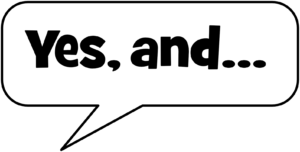By Rose O. Sherman, EdD, RN, NEA-BC, FAAN
Have you observed in meetings how when a new idea is introduced, someone in the room inevitably responds with yes, but…..
- we tried it before
- we don’t have the budget
- we have too many other priorities
The but is a conversation killer. It sends the message that whoever brings up the new idea is being denied the opportunity to go further. Often it is said by someone who enjoys the role of devils advocate and wants to look smart and discerning. A slight shift in language to “yes, and” can become a powerful tool for collaboration, negotiation and effective communication. It makes people feel valued, supported and heard.
The origins of “yes, and” started in the world of improvisation with Second City in Chicago. Comic improvisation is an art form where 5-6 actors arrive on the stage with no scripts, props or costumes. The show has a general topic but the actors have to create the show in the moment without knowing where it is headed. It works because of the “yes, and” approach. One actor starts the conversation with a topic like …..last night I had dinner with my mother…..a second actor will jump in with “yes, and” what did she make for dinner? The conversation builds on this topic with the yes, and approach resulting in what looks like a one act play by constantly accepting what is being contributed onstage.
The “yes, and” approach can be very powerful for leaders. It send the message that you are open and want to give every idea an opportunity to be discussed. You don’t negate it, belittle it or disagree with it. Scott McDowell tried this in his own leadership practice. He found unintended and positive returns. When he was intentional about it, he realized that “it was remarkable and disheartening to note how often my first reaction to things is no”. Changing his language forced him to realize that every moment is a tiny choice.
Yes, and may not be right for every situation but try it in your own leadership practice. So the next time you are inclined to say something like but we don’t have the budget, try instead to frame it differently…….yes, and let’s figure out whether we can make this budget neutral. You may be surprised how that changes the conversation and how others view your leadership.
Read to Lead
Leonard, K. & Yorton, T. (2015). Yes, And: How Improvisation Reverses “No, But” Thinking and Improves Creativity and Collaboration—Lessons from the Second City. New York: Harper Business.
© emergingrnleader.com 2016



 LinkedIn
LinkedIn Instagram
Instagram